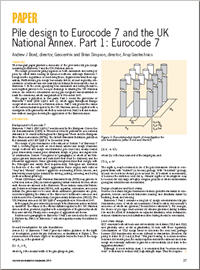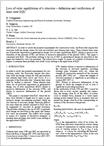 Pile design to Eurocode 7 and the UK National Annex Pile design to Eurocode 7 and the UK National Annex
Andrew J. Bond and Brian Simpson (2009-10).
Part 1: Eurocode 7, Ground Engineering, vol. 42, no 12, Dec 2009, pp27-31, London: Emap Inform; Part 2: UK National Annex, Ground Engineering, vol. 43, no 1, Jan 2010, pp28-31, London: Emap Inform.
Summary: This two-part paper presents a summary of the provisions for pile design according to Eurocode 7 and the UK National Annex. The design process for piling depends on both calculation and testing of piles, by either static loading or dynamic methods. Although Eurocode 7 recognises the importance of combining these, its provisions treat them separately. Furthermore, pile design has usually linked, at least implicitly, consideration of ultimate and serviceability limit states; this remains the case in Eurocode 7. In the event, specifying how calculation and testing should be used together proved to be a major challenge in drafting the UK National Annex. An extensive consultation among pile designers was undertaken in order to reach the consensus which was published in November 2007. The paper is published in two parts. Part 1 covers the provisions of Eurocode 7 itself (ENs 1997-1 and -2), which apply throughout Europe except where amended by a National Annex. Part 2 will present the values of the various factors required by the UK National Annex, together with a description of the process by which they were derived. Part 2 will also include two worked examples showing the application of the Eurocode rules.
 Loss of static equilibrium of a structure - definition and verification of limit state EQU Loss of static equilibrium of a structure - definition and verification of limit state EQU
Schuppener B., Simpson B., Orr T.L.L., Frank R., and Bond A.J. (2009), Proc. 2nd Int. Symp. on Geotechnical Safety and Risk, Gifu, Japan.
Abstract: Eurocode 7 has been described as an ‘umbrella’ code, which can accommodate various geotechnical practices, and as such is wellsuited for adoption not only throughout Europe but also in other parts of the world. This paper reviews Eurocode 7’s suitability in this regard and is divided into three parts: Part 1 provides an overview of Eurocode 7 Part 1; Part 2 discusses experience implementing thecode in Europe; and Part 3 summarizes attitudes towards the code in some non-European countries.
 Eurocode 7 for geotechnical design - a model code for non-EU countries Eurocode 7 for geotechnical design - a model code for non-EU countries
Schuppener B., Bond A.J., Day P., Frank R., Orr T.L.L., Scarpelli G., and Simpson B. (2009), Proc. 17th Int. Conf. on Soil Mechanics and Geotechnical Engineering, Alexandria, Egypt.
Abstract: In order to satisfy the essential requirements for construction works, the Eurocodes require that structures fulfil the design criteria for both serviceability and ultimate limit states. Three ultimate limit states are of particular importance in geotechnical design: loss of static equilibrium (EQU), failure or excessive de-formation of the structure (STR), and failure or excessive deformation of the ground (GEO). This paper is concerned with EQU. The problems relating to the use of EQU in geotechnical design are described in this paper and alternative views are presented. The authors have sought, by means of a number of illustrative ex-amples, to examine these problems and clarify issues relating to the application of EQU.
 When an irresistible force meets an immovable object When an irresistible force meets an immovable object
Dr Andrew Bond (2007), GeoDrilling International, April 2007.
Click here to download full article.
|